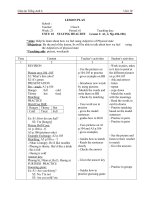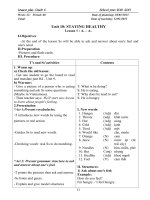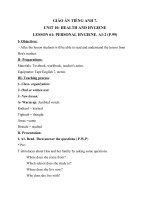Giáo án Tiếng Anh 8 unit 10: Recycling
Bạn đang xem bản rút gọn của tài liệu. Xem và tải ngay bản đầy đủ của tài liệu tại đây (136.65 KB, 14 trang )
GIÁO ÁN TIẾNG ANH LỚP 8.
UNIT 10: RECYCLING
Period 60: Getting started – Listen & read
A/Aim: To give the ps information about the environment problems
B/Objective: Ps will be able to do something to protect the environment & save natural
resources.
C/Preparation
Poster
D/Procedure
I. Getting started: Brainstorm
- T draws the circle with an example on the board
Ways to reduce the
amount of garbage
Reuse plastic bags
- Ss work in groups of 4.
* Feedback
* Possible answers:
- T use cloth bags, use tree leaves to wrap things, make garbage into fertilizer, make
vegetable matter into animal food.
II. Listen & read:
1) New words:
- T elicits words from Ps
+ representative (n) : người đại diện , tiêu biểu (Trans)
+ to protect (to keep s.o / sth safe from danger) : bảo vệ
→ to protect (s.o / sth) from (s.o / sth)
+ natural resources : tài nguyên thiên nhiên
+ to recycle
: tái sử dụng
(Trans)
+ to reduce
: giảm bớt
+ to over package
: đóng gói
2) Activity 1:
Set the scene:
A representative from friends of the Earth, Miss Blake, is talking to the students of
Quang Trung school. Friends of the Earth shows people how to protect the
environment & save natural resources.
Poster:
a) Friends of the Earth is an organization to help people make friends with each
other
b) Miss Blake asks the students to remember 3 things: reduce, reuse, recycle.
c) Reduce means buying the products which are over packed.
d) We can’t reuse things like envelopes, glass, plastic bottles, old plastic bags.
e) Miss Blake says that we should use cloth bags and shouldn’t use plastic bags at
all.
f) Recycling means not just throwing things away but trying and finding another use
for them.
- Ss work in groups of 4
* Feedback
3) Activity 2:
- Ss listen to the tape and check their prediction
- Ss open their books; listen to the tape while reading ( in silence) the dialogue
* Feedback of the Ps.
- T corrects
- Ss correct the false statements.
4) Activity 3:
- T asks Ps to read the dialogue again then answer the questions
- Ss work in pairs & share with their partners
* Feedback on the board
- T corrects
5) Activity 4 :Ps act out the dialogue (in pairs)
6) Activity 5 : Grammar point :
adjective
+ that clause .
Ex : I’m pleased that you want to know more.
She ‘s excited that her English is better and better.
7) Activity 6 : discussion
- T writes the topic on the board.
What do we do to protect our environment?
- T asks Ss to express their opinions / ideas on this topic
- Write the Ss ideas on the board into a list.
- Give feedback, correct & have Ss copy.
III. Homework:
Write the questions & full answers in your exercise notebooks.
UNIT 10: RECYCLING
Period 61: Speak - Listen
A. Aim: Help Ps practice speaking in giving & responding to instructions & listening for
specific information about making compost
B. Objective: Ps can give & respond to instructions.
C. Preparation: posters , picture, handouts.
D. Procedure
I. Warm up: Kim’s game
The picture in text book (speak) a heap of garbage.
Possible answer:
Used paper, old newspapers, books, cardboard, boxes, bottles, glasses, jars, plastic
bags, food cans, drinking tins, vegetables matter, clothes, shoes, schoolbags….
I. Speak :
1) Pre-teach vocabulary:
+ fertilizer (exp) → To fertilize
+ compost: what do you call the fertilizer made from spoiled food, leaves,
vegetable matter…? → A compost heap
+ Fabric (regalia: clothes)
+ Leather: our shoes, sandals are often made of…
Checking: ROR
2) Dictation list:
Poster:
- T ask Ss to look at the picture & decide which group each item belongs to
Group
Paper
Items
Used paper (old newspapers, books….)
Glass
Bottles, glasses, jars.
Plastic
Plastic bags, plastic bottles
Metal
Food cans, drinking tins
Fabric
Clothes ( cloth bags, material)
Leather
Shoes, sandals, schoolbags
Vegetable Matter
Fruit peels, (vegetables, rotten fruits)
- Ss work in pairs - * Feedback- T corrects
3) Mapped dialogue:
Which group (do clothes) belong to?
Put (them) in (fabric)
What can we do with (those clothes)?
We can (recycle them & make
them into paper & shopping bags)
Are / is (fruit vegetable matter)?
What’ll we do with it?
That’s right
We make (it into compost & fertilizer
our field)
- Ss work in pairs ( replacing the information with the words in the dictation list )
- T monitors and corrects .
I. Listen :
1. Multiple choice:
- Ss read the multiple choice questions on page 91 then guess how people make compost.
* Pair work
* Feedback
- Ss listen to the tape 2 times:
+ check their prediction
+ correct
2. Deliberate mistakes: Handout
We can put all types of garbage in the compost. The place that gets no sun & shade is
the best place for a compost heap. We shouldn’t water the compost oftenly and after 6
weeks, we can use it as fertilizer.
- Ss work in individual
- Share with a partner
- Ss listen & correct.
III .Homework: - Listen about how to make compost.
- Practise & learn by heart the mapped dialogue.
UNIT 10: RECYCLING
Period 62: Read
A. Aim: Reading for details about how things are recycled
B. Objective: By the end of the lesson, Ss will be able to understand some things about
recycling
& protecting the
environment.
C. Preparation: Poster
D. Procedure:
I. Warm-up :
Jumbled words
1. eeyrlcc
=
2. lltcceo
=
3. iirreeltfz
=
4. mpootsc
=
5. oecttrp
=
6. vrnmnneioet
=
II. New lesson:
1) Pre-teach vocabulary:
+ tire
: lốp , vỏ xe ô tô
(picture)
+ pipe
: ống dẫn
(drawing)
+ (a) deposit
: tiền đặt cọc
(Trans)
+ (to) refill
: làm đầy lại
(exp)
+ (to) melt ≠ to freeze
: nấu chảy # đông đặc
( antonymn )
- T models , Ss' repetition : chorus - individually .- Ss copy down the words .
Checking vocabulary : R . O . R
2) Open prediction: (Group work)
- T asks the Ss to answer 2 questions a) What do people do with used things?
b) What can they make from them?
Car tires _______________________________
Milk bottles ____________________________
Glass _________________________________
Drink cans _____________________________
Household & garden waste ________________
3) Grid: (Read 2)
- T asks the Ss to read the text then fill in the grid (pair works)
Used things
- Car tired
Recycling facts
- Are recycled to make pipes & floor
- Milk bottles
recovering
glass.
- Are cleaned & refilled with milk is broken
- Drink cans
up, melted & made into new glassware.
-Household and - Are brought back for recycling.
garden waste.
- Is made into compost.
- Ss work in pairs and share with the partners - * Feedback - T corrects
4) Comprehension questions: (Read 1)
- T asks Ss to answer the questions
- Ss work in individual and share with the partner - * Feedback
- T corrects
III.Homework:
Do the exercise 1, 2 page 93 again.
Preparation new lesson: Unit 10: Wtite.
UNIT 10: RECYCLING
Period 63: Write
A. Aim: To help Ps to write a set of instructions on how to recycle used things
B. Objective: By the end of the lesson, Ps will be able to write a set of instructions, using
the sequencing
C. Preparation:
D. Procedure:
I. Pre-teach vocabulary:
+ (to) soak
: dầm nước , ngâm nước
(expel)
+ (to) mash
: nghiền nhừ
(mime)
+ wire mesh
: lưới kim loại
(trans)
+ bucket
: cái xô
(drawing)
Checking vocabulary : Slap the board
b) Ordering prediction
- Set the scene: You’re going to read a text about how to recycle used paper.
- Now let guess the order of the actions:
Soak, dry, pull out, mix, press, mash.
- Ps work in groups of 4
+ Feedback
* Answer key:
Soak, mash, mix, pull out, press, dry.
II. While writing
a) T asks the Ps to open their books, read the text on page 93 and fill in the verbs
- Ps work in individual and share with a partner
* Feedback
- T corrects
1. Use
2. Mix
3. Place
4. Press
5. Wrap 6. wait
b) Recall:
- T asks the Ss to close their books
- T write the sequencing on the board and have Ss practice speaking first
- T calls on Ss to say the sentences from memory.
First, ……………….
Then, ………............
Next, ………………
After that, …………
Finally, ……………
- Ss work in pairs
- T monitors & help the Ss with their work
* Answer key.
7. Dry
_First, soak old newspapers in a bucket overnight
_Then, mash the paper by a wooden spoon
_Next, mix the mashed paper with water
_After that, use a wire mesh to pull the mixture out, put it on the cloth and press it
down firmly
_Finally, take the mesh out of the cloth & dry it in the sun
III. Post-writing:
Ordering pictures
- T sticks the photocopied picture on the board randomly.
- T asks the Ss to listen and work in groups to rearrange the pictures according to the
instructions on how to prepare the tea leaves
- T reads the instructions aloud
a. First take the used tea leaves from the tea pot
b. Next scatter the tea leaves on a tray
c. Then dry the leaves in the sun
d. Finally, put the dry leaves in a pot for future use
* Feedback
- T corrects
IV. Homework: Write the instructions on how to make a thing you have ever made,
using the sequencing
UNIT 10: RECYCLING
Period 64: Language focus
A. Aim: Passive forms:
To be + adj +
SHAPE \* MERGEFORMAT
to-inf
+ That clause
B. Objective: By the end of the lesson, Ss will be able to form the passive in Future
Simple, Present simple and structures with adjectives
C. Preparation: Extra board.
D. Procedure:
I. Language focus 1:
- T elicits the model sentences from Ss
+ Car tires are recycled to make pipes & floor recovering
+ Glass is recycled into new glass ware
Form: Passive form in the present simple
S + am / is / are + past participle
Usage: It’s used when the subject is affected by the action of the verb
•
How to change an active sentence to a passive one
Active
S
V
O
Passive
S
Eg:
I
be + pp
by O
love
My parents
my parents
are loved
by me
1) Ordering pictures:
- T asks the Ss to read the instructions and look at the pictures on page 95
- Ss put the pictures in the correct order according to the instructions
- Ss work in groups then share
* Feed back
Answer key: a.1
b.4
c.3
d.5
e.2
f.6
- Teacher asks Ss to write the sentences in LF1 in the passive form
II. Language focus 2:
1) Set the scene:
- T asks the Ss to listen to the situation." A famous inventor, Dr Kim is going to build a
time machine. One of his assistants; Hai, is asking him questions about the invention. He
wants to know when Dr Kim will start the project. How can he say the sentence in
Passive?
2) Concept checking:
Use: Passive form in the future Simple
Form: Will / shall + be + p.p.
- Ss practice doing the exercise in textbook
- T corrects
III. Language focus 3:
1) Set the scene: Ba gives Nam a lot of directions at a time so Nam finds it difficult
to follow Ba’s directions. What dose he say to Nam?
•
Model sentence:
It
is
difficult
to follow your directions
It
be
adj
to-infi
•
Concept checking:
Form: It + be + adj + to-infi
2) Gap-fill:
- Ss open their books and complete the dialogue on page 96
- Ss work in pairs
- T corrects
IV. Language focus 4 :
1) Set the scene: Nam passed the E. exam and his grand parents are delighted at
it. What did they write to him?
• Model sentence:
We
are
delighted
that you passed the E. exam
S
be
adj
that + clause
• Concept checking:
Form: S + be + adj + that + clause
2) Gap-fill:
- Ss work in pairs to complete the letter using the words in the box
* Feedback
- T corrects
V.Homework: Do the exercise 5, 6, 7 / 64, 65 in your workbook.









